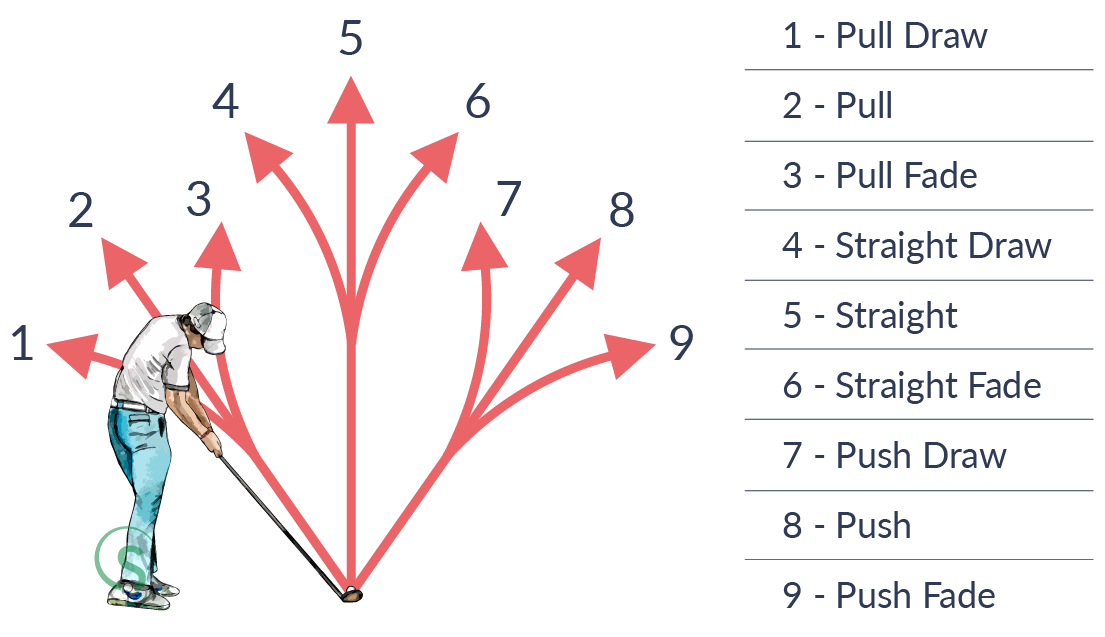Ball Flight
This is a beginner’s guide to ball flight and about all you need to know on the subject to make it onto the PGA Tour. But if you’d like to learn more about the physics and geometry of impact, you’ll find it later on in the Ball Behaviour topic. Until then, here are the nine different ball flights, and briefly why the ball travels on these paths.
Ball flights are classified by two criteria: their initial direction (straight at the target, left of target or right of target), and then by any curvature after taking this initial direction (continuing in a straight line, curving to the left of the initial direction or curving to the right of the initial direction).
Ball flights are classified by two criteria: their initial direction (straight at the target, left of target or right of target), and then by any curvature after taking this initial direction (continuing in a straight line, curving to the left of the initial direction or curving to the right of the initial direction).

At this point I’d like to make clear the differences between a fade/slice and draw/hook. They’re arbitrary definitions based on the magnitude of the curved flight. If the ball curves to the right a little bit, it’s generally known as a fade. If it curves to the right by a large, and typically unwanted, amount it’s generally known as a slice. The same goes for the (small) draw and (big) hook.
So we’ve identified pull-type shots where the ball begins left of target, push-type shots where the ball begins right of target and straight-type shots.
What causes these initial directions? Predominately it’s the clubface. If the clubface is pointing left of target at Separation, that’s where the ball will begin its journey. Likewise, if the clubface is pointing directly at the target, or right of target at Separation, the ball will initially fly at the target, or right of target respectively.(1)
The initial flight is simple enough to understand, but what causes the ball to curve left or right after it’s taken off? That’s due to a principle known as the Magnus Effect.(2) If, during the Impact Interval, the applied force from the clubface does not pass exactly through the longitudinal centre of the ball, the clubface will impart varying amounts of clockwise or anti-clockwise spin on the ball when viewed from above.(3)
This spinning ball, when moving through the air will have an area of low pressure where the air is moving in the same direction as the spin of the ball, and an area of high pressure, where the air is moving against the spin of the ball.
A ball hit with backspin only (no clockwise / anti-clockwise spin when viewed from above) will have its area of low pressure at the top of the ball, and high pressure at the bottom. This imbalance of air pressure around the ball will force the ball upwards, away from the high pressure, and towards the low pressure above it.
When a ball is spinning in a clockwise direction, there is high pressure on the left hand side of the ball, and low pressure on the right. This pushes the ball to the right, causing a fade/slice curved flight. An anti-clockwise spin has low pressure to the left of the ball and high pressure to the right, pushing the ball to the left and resulting in the draw / hook curved flight.
In summary, the initial flight of the ball is due to where the clubface is pointing at Separation, and the curved ball flight after this is due to clockwise or anti-clockwise spin imparted on the ball during the Impact Interval.
So we’ve identified pull-type shots where the ball begins left of target, push-type shots where the ball begins right of target and straight-type shots.
What causes these initial directions? Predominately it’s the clubface. If the clubface is pointing left of target at Separation, that’s where the ball will begin its journey. Likewise, if the clubface is pointing directly at the target, or right of target at Separation, the ball will initially fly at the target, or right of target respectively.(1)
The initial flight is simple enough to understand, but what causes the ball to curve left or right after it’s taken off? That’s due to a principle known as the Magnus Effect.(2) If, during the Impact Interval, the applied force from the clubface does not pass exactly through the longitudinal centre of the ball, the clubface will impart varying amounts of clockwise or anti-clockwise spin on the ball when viewed from above.(3)
This spinning ball, when moving through the air will have an area of low pressure where the air is moving in the same direction as the spin of the ball, and an area of high pressure, where the air is moving against the spin of the ball.
A ball hit with backspin only (no clockwise / anti-clockwise spin when viewed from above) will have its area of low pressure at the top of the ball, and high pressure at the bottom. This imbalance of air pressure around the ball will force the ball upwards, away from the high pressure, and towards the low pressure above it.
When a ball is spinning in a clockwise direction, there is high pressure on the left hand side of the ball, and low pressure on the right. This pushes the ball to the right, causing a fade/slice curved flight. An anti-clockwise spin has low pressure to the left of the ball and high pressure to the right, pushing the ball to the left and resulting in the draw / hook curved flight.
In summary, the initial flight of the ball is due to where the clubface is pointing at Separation, and the curved ball flight after this is due to clockwise or anti-clockwise spin imparted on the ball during the Impact Interval.
